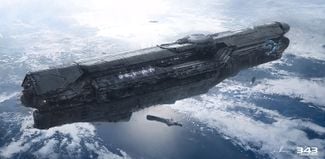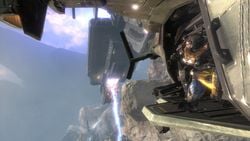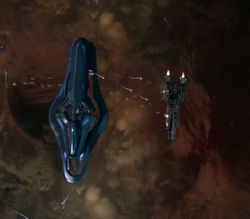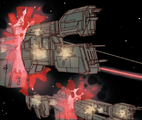Titanium-A armor: Difference between revisions
From Halopedia, the Halo wiki
Legion1984 (talk | contribs) No edit summary |
m (→Gallery: image replacement, replaced: ArabiaVostok.png → HWG ArabiaVostok.png) |
||
| (21 intermediate revisions by 11 users not shown) | |||
| Line 1: | Line 1: | ||
{{ | {{Status|Canon}} | ||
[[File:H4 UNSCInfinity Concept 1.jpg|thumb|325px|Most UNSC military vessels, such as the {{UNSCShip|Infinity}}, are armored with Titanium-A plating.]] | |||
'''Titanium-A armor''' is the most common form of battle plating used by [[Human starship|starships]] constructed by [[human]]ity. It is employed on both civilian and [[Warship|military vessels]] as a general-use hull material designed to protect the spacecraft in question from damage ranging from micrometeorite impacts to hypervelocity projectile rounds and [[directed-energy weapon]]s.{{Ref/Book|Id=Enc22|Enc22|Page=114}} | |||
==Overview== | |||
===Characteristics=== | |||
Titanium-A consists of high-grade [[Titanium]]-50,{{Ref/Novel|GoO|Chapter=22}} specially-strengthened and reinforced at the molecular level{{Ref/Reuse|Enc11}} with stacked nanotubes, elastic polymer composites and intermetallic laminates - resulting in a plating material capable of withstanding hypervelocity projectile impacts and energy weapon attacks.{{Ref/Reuse|Enc22}}{{Ref/Book|Id=WF19|HWF|Page=19}} The plates themselves are typically a dull grey in colouration, and are embedded with thermal superconducting radiators that work to radiate thermal energy from the ship into space.{{Ref/Book|HM|Page=83}} The space between individual armor plates is filled with shock-hardening fluids and encapsulated healing agents to reduce spall from impacts and automatically seal small hull breaches.{{Ref/Reuse|WF19}} | |||
====Titanium-A3 armor==== | |||
Later during the [[Human-Covenant War]], more advanced forms of Titanium-A were introduced, fitted with thermal superconducting elements to help strengthen against energy weapon impacts.{{Ref/Reuse|Enc22}} One such example is Titanium-A3, a variant of Titanium-A battle plate developed by the [[Office of Naval Intelligence]]'s [[Materials Group]]. Like Titanium-A, it is chemically altered on the molecular level to produce a stronger plate for ship hulls. It has only been noted to be used on the {{UNSCShip|Infinity}}, whose hull is composed of 4.9-meter-thick Titanium-A3 battleplate.{{Ref/Game|H4|[[Infinity Briefing Packet]]}} | |||
Following the [[Human-Covenant War]], some UNSC military vessels received [[energy shielding]] to allow the ships to absorb more damage.{{Ref/SpOps|Departure}} | |||
===Defensive capabilities=== | ===Defensive capabilities=== | ||
[[File:Energy Projector.jpg|thumb|left|250px| | [[File:Energy Projector.jpg|thumb|left|250px|{{UNSCShip|Grafton}} is destroyed by a single [[energy projector]] shot.]] | ||
Prior to the [[Human-Covenant War]], a single [[Magnetic Accelerator Cannon]] slug was capable of penetrating any vessel's Titanium-A armor plating. | Prior to the [[Human-Covenant War]], a single [[Magnetic Accelerator Cannon]] slug was capable of penetrating any vessel's Titanium-A armor plating.{{Ref/Novel|HCH|Chapter=7}} The armor took a newfound importance after the beginning of the Human-Covenant War: to contend with the [[Covenant]]'s [[plasma weaponry]], [[human]]s needed armor that would withstand the heat of the directed plasma. Despite its strength and resistance to heat, however, the Titanium-A plating is usually boiled away within seconds on contact with Covenant [[plasma torpedo]]es, and does not effectively dissipate the plasma. [[Energy projector]]s are able to pierce dozens of centimeters with relative ease.{{Ref/Reuse|Enc11}}{{Ref/Comic|HE|Issue=5}}{{Ref/Comic|HE|Issue=6}}{{Ref/Level|HR|Tip of the Spear}} [[Pulse laser turret]]s can reduce the hull of a heavy frigate to about four centimeters in a single hit.{{Ref/Novel|HTFoR|Chapter=11}} Even [[Energy sword (fiction)|energy swords]] can do significant damage to Titanium-A armor.{{Ref/Novel|HFS|Chapter=8}} | ||
Titanium-A armor plating can be layered with [[tungsten]] for a radiation absorption rating of 5 and presumably grant greater protection against [[plasma]] weaponry.{{Ref/Anthology|Evo|The Impossible Life and Possible Death of Preston J. Cole|Section=7}} Unlike the Covenant's [[nanolaminate hull plating]], Titanium-A plating is not effective during direct collisions with other vessels. After a direct collision with ''[[Proclamation's Tithe]]'', the {{UNSCShip|Spirit of Fire}} was heavily damaged, while the {{Pattern|Sinaris|heavy destroyer}} was seemingly unharmed.{{Ref/Level|HW|Repairs}} When the destroyer {{UNSCShip|Iroquois}} collided with a [[Covenant stealth ship]], the ''Iroquois'' lost all two meters of Titanium-A plating, although it did succeed to disabling the Covenant vessel.{{Ref/Novel|HTFoR|Chapter=18}} | |||
===Usage=== | |||
[[File:Reach 596390 Medium.jpg|thumb|250px|{{UNSCShip|Savannah}}'s hull holding its own against the ''[[Ardent Prayer]]'', despite being severely outgunned.]] | |||
Titanium-A, alongside other technologies such as [[Magnetic Accelerator Cannon]]s, was developed in the 25th century as a response to the [[Insurrection]].{{Ref/Anthology|Evo|The Impossible Life and Possible Death of Preston J. Cole|Section=4}} Since its introduction, it has served as the main hull material used on the warships of the [[CMA Navy]] and [[UNSC Navy]]. As much as a third of a given ship's mass may be composed of Titanium-A, with plate thicknesses often measuring dozens of centimetres thick.{{Ref/Book|Id=Enc11|Enc11|Page=315}} [[UNSC frigate|Frigates]] such as the {{Class|Paris|heavy frigate}} may have up to {{Convert|60|cm|in}} of Titanium-A plating,{{Ref/Novel|HFS|Chapter=22}}{{Ref/Book|Id=Enc11Plating|Enc11|Page=258-261}} with [[UNSC destroyer|destroyers]] like the {{Class|Halberd|light destroyer|}} having plates as thick as {{Convert|2|m|ft}}.{{Ref/Novel|HTFoR|Chapter=Prologue}}{{Ref/Reuse|Enc11Plating}} {{Class|Marathon|heavy cruiser}}s, the standard line warship of the UNSC Navy, have plates with {{Convert|191|cm|in}} of Titanium-A,{{Ref/Book|EVG|Page=42}} while some [[UNSC carrier|carriers]] have armour plating thickness of {{Convert|36|cm|in}}.{{Ref/Reuse|Enc11Plating}} Other carriers, such as {{UNSCShip|Stalingrad}}, have multiple metres of Titanium-A plate.{{Ref/Novel|GoO|Chapter=32}} Outside of warships, Titanium-A armour is used as the hull material for support craft such as the [[D77-TC Pelican]]{{Ref/Novel|HFS|Chapter=1}} and [[GA-TL1 Longsword]],{{Ref/Novel|Id=FS5|HFS|Chapter=5}} alongside [[slipstream space probe]]s{{Ref/Novel|HFS|Chapter=32}} and even [[drop pod]]s such as [[Long range stealth orbital drop pod]]s.{{Ref/Novel|GoO|Chapter=Prologue}} [[Refit station]]s{{Ref/Novel|HTFoR|Chapter=33}} and construction platforms, such as [[Station Delphi]], are essentially slabs of Titanium-A armor plating.<ref>'''Halo: Ghosts of Onyx''', ''page 51''</ref> | |||
The UNSC uses Titanium-A for construction of [[military base]]s as well, to make them less susceptible to destruction. Underground facilities such as [[HIGHCOM Facility Bravo-6]], [[CASTLE Base]]{{Ref/Novel|HFS|Chapter=11}} and [[Camp Hathcock]] used Titanium-A armor in their superstructures.{{Ref/Novel|HTFoR|Chapter=24}} Even lockers used by UNSC personnel are reinforced with a centimeter of Titanium-A armor plating.{{Ref/Reuse|FS5}} [[Eridanus Secundus]], a [[United Rebel Front]] [[asteroid]] base located in the [[Eridanus system]], was reinforced with a layer of Titanium-A armor which also helps deflect UNSC and Covenant sensors.{{Ref/Novel|HFS|Chapter=28}} On an infantry level, Titanium-A serves as the primary material layer for the armoured shell of the [[MJOLNIR Powered Assault Armor]] system,{{Ref/Book|Enc22|Page=81}} and is even used in infantry equipment such as the [[grappleshot]].{{Ref/Book|Enc22|Page=85}} | |||
{{ | |||
In the civilian world, noncombat starships such as freighters may also be covered in a layer of Titanium-A, albeit much thinner and their military counterparts. These armour layers serve to protect the ship from regular space debris such as micrometeorites, as opposed to hostile projectiles.{{Ref/Reuse|Enc22}} | |||
==Gallery== | ==Gallery== | ||
<gallery> | <gallery> | ||
File:ApexBattleImage.png|The {{UNSCShip|Spirit of Fire}} is heavily damaged by a collision with a Covenant [[ | File:ApexBattleImage.png|The {{UNSCShip|Spirit of Fire}} is heavily damaged by a collision with a Covenant [[Sinaris-pattern heavy destroyer|destroyer]]. | ||
File:AutumnDamagedCEA.png|The {{UNSCShip|Pillar of Autumn}}'s modified hull is damaged by [[plasma turret]]s. | File:AutumnDamagedCEA.png|The {{UNSCShip|Pillar of Autumn}}'s modified hull is damaged by [[plasma turret]]s. | ||
File:Infinity attacked.... by a third time.jpg|The {{UNSCShip|Infinity}}'s unshielded hull is pierced by [[Oth Lodon station|a glassing station]]. | File:Infinity attacked.... by a third time.jpg|The {{UNSCShip|Infinity}}'s unshielded hull is pierced by [[Oth Lodon station|a glassing station]]. | ||
File:ArabiaVostok.png|Two ''Charon''-class frigates hulls are easily destroyed by plasma turrets. | File:HWG ArabiaVostok.png|Two ''Charon''-class frigates hulls are easily destroyed by plasma turrets. | ||
File:Longsword-class Interceptor.png|A [[Longsword]]'s hull is made up of Titanium-A armor. | File:Longsword-class Interceptor.png|A [[Longsword]]'s hull is made up of Titanium-A armor. | ||
File:H2A Cutscene EnergyProjectorPiercing.png|A {{Class|Marathon|heavy cruiser}}'s hull being pierced by a {{Class|CAS|assault carrier}}'s energy projector. | File:H2A Cutscene EnergyProjectorPiercing.png|A {{Class|Marathon|heavy cruiser}}'s hull being pierced by a {{Class|CAS|assault carrier}}'s energy projector. | ||
</gallery> | </gallery> | ||
==Sources== | ==Sources== | ||
{{Ref/Sources|2}} | {{Ref/Sources|2}} | ||
[[Category:Armor]] | [[Category:Armor]] | ||
[[Category:Materials]] | [[Category:Materials]] | ||
Latest revision as of 11:36, January 27, 2024

Titanium-A armor is the most common form of battle plating used by starships constructed by humanity. It is employed on both civilian and military vessels as a general-use hull material designed to protect the spacecraft in question from damage ranging from micrometeorite impacts to hypervelocity projectile rounds and directed-energy weapons.[1]
Overview[edit]
Characteristics[edit]
Titanium-A consists of high-grade Titanium-50,[2] specially-strengthened and reinforced at the molecular level[3] with stacked nanotubes, elastic polymer composites and intermetallic laminates - resulting in a plating material capable of withstanding hypervelocity projectile impacts and energy weapon attacks.[1][4] The plates themselves are typically a dull grey in colouration, and are embedded with thermal superconducting radiators that work to radiate thermal energy from the ship into space.[5] The space between individual armor plates is filled with shock-hardening fluids and encapsulated healing agents to reduce spall from impacts and automatically seal small hull breaches.[4]
Titanium-A3 armor[edit]
Later during the Human-Covenant War, more advanced forms of Titanium-A were introduced, fitted with thermal superconducting elements to help strengthen against energy weapon impacts.[1] One such example is Titanium-A3, a variant of Titanium-A battle plate developed by the Office of Naval Intelligence's Materials Group. Like Titanium-A, it is chemically altered on the molecular level to produce a stronger plate for ship hulls. It has only been noted to be used on the UNSC Infinity, whose hull is composed of 4.9-meter-thick Titanium-A3 battleplate.[6]
Following the Human-Covenant War, some UNSC military vessels received energy shielding to allow the ships to absorb more damage.[7]
Defensive capabilities[edit]
Prior to the Human-Covenant War, a single Magnetic Accelerator Cannon slug was capable of penetrating any vessel's Titanium-A armor plating.[8] The armor took a newfound importance after the beginning of the Human-Covenant War: to contend with the Covenant's plasma weaponry, humans needed armor that would withstand the heat of the directed plasma. Despite its strength and resistance to heat, however, the Titanium-A plating is usually boiled away within seconds on contact with Covenant plasma torpedoes, and does not effectively dissipate the plasma. Energy projectors are able to pierce dozens of centimeters with relative ease.[3][9][10][11] Pulse laser turrets can reduce the hull of a heavy frigate to about four centimeters in a single hit.[12] Even energy swords can do significant damage to Titanium-A armor.[13]
Titanium-A armor plating can be layered with tungsten for a radiation absorption rating of 5 and presumably grant greater protection against plasma weaponry.[14] Unlike the Covenant's nanolaminate hull plating, Titanium-A plating is not effective during direct collisions with other vessels. After a direct collision with Proclamation's Tithe, the UNSC Spirit of Fire was heavily damaged, while the Sinaris-pattern heavy destroyer was seemingly unharmed.[15] When the destroyer UNSC Iroquois collided with a Covenant stealth ship, the Iroquois lost all two meters of Titanium-A plating, although it did succeed to disabling the Covenant vessel.[16]
Usage[edit]
Titanium-A, alongside other technologies such as Magnetic Accelerator Cannons, was developed in the 25th century as a response to the Insurrection.[17] Since its introduction, it has served as the main hull material used on the warships of the CMA Navy and UNSC Navy. As much as a third of a given ship's mass may be composed of Titanium-A, with plate thicknesses often measuring dozens of centimetres thick.[3] Frigates such as the Paris-class heavy frigate may have up to 60 centimetres (24 in) of Titanium-A plating,[18][19] with destroyers like the Halberd-class having plates as thick as 2 metres (6.6 ft).[20][19] Marathon-class heavy cruisers, the standard line warship of the UNSC Navy, have plates with 191 centimetres (75 in) of Titanium-A,[21] while some carriers have armour plating thickness of 36 centimetres (14 in).[19] Other carriers, such as UNSC Stalingrad, have multiple metres of Titanium-A plate.[22] Outside of warships, Titanium-A armour is used as the hull material for support craft such as the D77-TC Pelican[23] and GA-TL1 Longsword,[24] alongside slipstream space probes[25] and even drop pods such as Long range stealth orbital drop pods.[26] Refit stations[27] and construction platforms, such as Station Delphi, are essentially slabs of Titanium-A armor plating.[28]
The UNSC uses Titanium-A for construction of military bases as well, to make them less susceptible to destruction. Underground facilities such as HIGHCOM Facility Bravo-6, CASTLE Base[29] and Camp Hathcock used Titanium-A armor in their superstructures.[30] Even lockers used by UNSC personnel are reinforced with a centimeter of Titanium-A armor plating.[24] Eridanus Secundus, a United Rebel Front asteroid base located in the Eridanus system, was reinforced with a layer of Titanium-A armor which also helps deflect UNSC and Covenant sensors.[31] On an infantry level, Titanium-A serves as the primary material layer for the armoured shell of the MJOLNIR Powered Assault Armor system,[32] and is even used in infantry equipment such as the grappleshot.[33]
In the civilian world, noncombat starships such as freighters may also be covered in a layer of Titanium-A, albeit much thinner and their military counterparts. These armour layers serve to protect the ship from regular space debris such as micrometeorites, as opposed to hostile projectiles.[1]
Gallery[edit]
The UNSC Spirit of Fire is heavily damaged by a collision with a Covenant destroyer.
The UNSC Pillar of Autumn's modified hull is damaged by plasma turrets.
The UNSC Infinity's unshielded hull is pierced by a glassing station.
A Longsword's hull is made up of Titanium-A armor.
A Marathon-class heavy cruiser's hull being pierced by a CAS-class assault carrier's energy projector.
Sources[edit]
- ^ a b c d Halo Encyclopedia (2022 edition), page 114
- ^ Halo: Ghosts of Onyx, chapter 22
- ^ a b c Halo Encyclopedia (2011 edition), page 315
- ^ a b Halo: Warfleet, page 19
- ^ Halo Mythos, page 83
- ^ Halo 4, Infinity Briefing Packet
- ^ Halo 4 - Spartan Ops, episode Departure
- ^ Halo: Contact Harvest, chapter 7
- ^ Halo: Escalation, issue 5
- ^ Halo: Escalation, issue 6
- ^ Halo: Reach, campaign level Tip of the Spear
- ^ Halo: The Fall of Reach, chapter 11
- ^ Halo: First Strike, chapter 8
- ^ Halo: Evolutions - The Impossible Life and Possible Death of Preston J. Cole, section 7
- ^ Halo Wars, campaign level Repairs
- ^ Halo: The Fall of Reach, chapter 18
- ^ Halo: Evolutions - The Impossible Life and Possible Death of Preston J. Cole, section 4
- ^ Halo: First Strike, chapter 22
- ^ a b c Halo Encyclopedia (2011 edition), page 258-261
- ^ Halo: The Fall of Reach, Prologue
- ^ Halo: The Essential Visual Guide, page 42
- ^ Halo: Ghosts of Onyx, chapter 32
- ^ Halo: First Strike, chapter 1
- ^ a b Halo: First Strike, chapter 5
- ^ Halo: First Strike, chapter 32
- ^ Halo: Ghosts of Onyx, Prologue
- ^ Halo: The Fall of Reach, chapter 33
- ^ Halo: Ghosts of Onyx, page 51
- ^ Halo: First Strike, chapter 11
- ^ Halo: The Fall of Reach, chapter 24
- ^ Halo: First Strike, chapter 28
- ^ Halo Encyclopedia (2022 edition), page 81
- ^ Halo Encyclopedia (2022 edition), page 85







